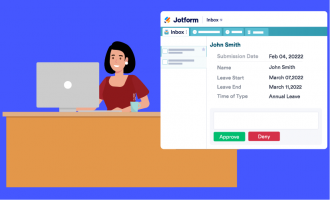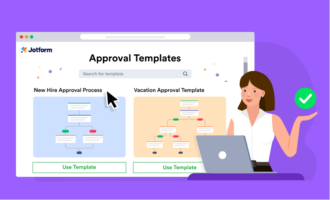Tips to create an employee suggestion program
- Create clear guidelines for suggestions
- Promote the program
- Decide on incentives
- Consider your work culture
The best employers strive to create a business where processes run smoothly, employees are engaged, and customers are happy.
But this isn’t the result of one person’s efforts — making a business successful literally takes a village. While many organizations have teams focused on organizational improvement, sometimes the best ideas come from unexpected places.
Developing an employee suggestion program is one way to gain access to ideas that might be taking shape in those places. Also known as an employee suggestion box, it gives employees in all parts of your organization a way to voice their thoughts on how to make the workplace better, faster, and more engaging. Your “box” could be either a physical or digital space where employees can share their ideas, either anonymously or not.
In this article, we’ll discuss the benefits of employee suggestion programs and help you determine whether one might be right for you. We’ll also show you what to do (and what not to do) when setting up a program at your organization. Plus, we’ll explain how you can use Jotform to get your program up and running quickly.
The benefits of employee suggestion programs
Employee suggestion programs are beneficial for both organizations and employees for these reasons:
- They boost employee engagement. When organizations ask employees for their opinions and ideas, it encourages employees to get more involved for the betterment of the company. However, it’s important to note that this increased engagement only happens when employees see that leadership is actually putting their ideas into action, rather than allowing them to sit in a black hole suggestion box.
- They create more effective processes and systems. Employees are involved with the organization’s day-to-day processes and systems. This gives them a unique advantage over management and executive-level personnel because they’re able to see firsthand what’s working and what’s not. They’re also in a great position to recommend realistic improvements.
- They lead to happier customers. When the business is running effectively, customers end up happier. With faster processes and more efficient systems, employees are able to meet customer needs with ease.
The right situation for an employee suggestion program
While employee suggestion programs may produce some great outcomes, they’re not right for every organization. How can you tell whether an employee suggestion program is likely to work for your business?
One indicator is whether you have executive buy-in. Employees need to see that the leadership of the company supports the program and wants it to succeed. If there’s no enthusiasm at the top of the corporate ladder, ideas aren’t likely to come to fruition because they won’t have adequate resources.
Here’s another critical aspect to consider: Does your organization have a team or individual with the time and know-how to manage an employee suggestion program?
These initiatives require constant oversight. In order for the program to succeed, you’ll need someone to promote the program, monitor the suggestions that come in, identify the ones that have merit, and coordinate their implementation.
All of this requires time, human resources, and funds. Ideally, it’s best to have a cross-functional team — made up of people from different departments and levels — oversee the suggestion program so that all areas of the business have representation.
Last, there needs to be a sense of urgency and importance around the employee suggestion program. If your organization can’t prioritize employee suggestion program initiatives over other aspects of the business, it’s likely the program will fail, as employees may think that no one is listening to their suggestions.
Be sure to carefully consider whether such a program is right for your business and, if it is, build a strategy around it before launching.
Tips for creating an employee suggestion program
Your program will have a better chance of being successful if you take the following steps to prepare:
- Create clear guidelines for suggestions. Specify which aspects of the business you’re focusing on, what level of detail employees should provide for their ideas, and in what format they should communicate ideas. Also outline how often you’ll review the submissions.
- Promote the program. Employees are busy with their day-to-day tasks, so they may miss a single email about a new program. Be sure to discuss the program in meetings over the course of a few weeks to ensure everyone knows what it is, why you’re doing it, and how they can be a part of it.
- Decide on incentives. Some employees may be happy to contribute without a reward, but many will want something for their time and effort. Consider whether your team would appreciate monetary prizes, public recognition, or something else for their suggestions.
- Consider your work culture. If your workplace is all about collaboration and teamwork, an anonymous suggestion program may not suit your team. Similarly, if your employees primarily work independently, a suggestion program that involves brainstorming meetings may not be welcome. Consider how your employees are used to working and mesh the guidelines of the program into that style and culture.
Pitfalls to avoid with your employee suggestion program
Steer clear of these common mistakes that organizations make when implementing such programs:
- Insufficient resources: If there aren’t enough hours or funds dedicated to implementing and managing the program, it won’t get off the ground much less lead to lasting change. Plus, once employees notice that no one is reviewing their suggestions they’ll simply stop submitting them.
- Lack of clarity: Employees need to know the guidelines for submitting suggestions, as well as what happens when a program manager receives a suggestion. A muddled process and lack of transparency just lead to confusion among employees, who may become less inclined to participate.
- Low executive buy-in: It’s vital for managers and executives to show their support of the suggestion program. Employees know that if those in charge don’t approve of it, no one will take their suggestions seriously.
- Missed opportunities: Some organizations are simply slow to respond to employee suggestions, leaving employees feeling frustrated and unheard. The program needs to have a sense of urgency, and leadership should ensure quick implementation of certain suggestions in order to make a visible impact.
Easy employee suggestion program setup with Jotform
Create an employee suggestion program for your organizationquickly and easily with Jotform.
Instead of building a program from scratch, use Jotform’s templates to get a leg up, such as the suggestion box template or the issue suggestion template. You can customize any template down to the last detail, including text and visuals. In addition, it’s easy to add widgets to your suggestion form, such as numeric sliders and autocomplete fields, so the form meets your exact requirements.
Once it looks just how you want it, you can share the form via email or include the link or QR code in your HR emails and newsletters. You can even embed the form on your internal website for employees to fill out whenever they have an idea.
In addition, you can use Jotform Tables, a spreadsheet-database tool, to track, organize, and manage the responses to ensure you’re acting on employee suggestions.
Jotform is the ideal solution for improving your organization with the help of employee suggestions.
Photo by Tima Miroshnichenko









































Send Comment: